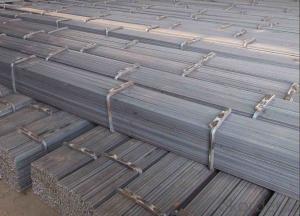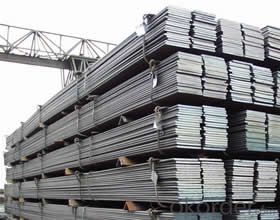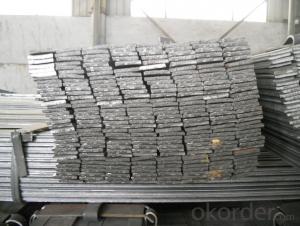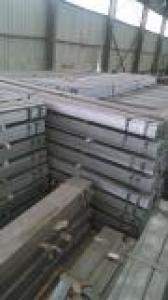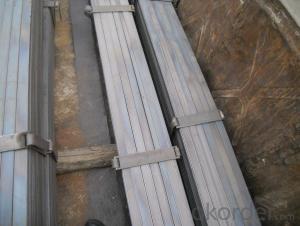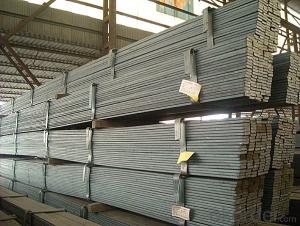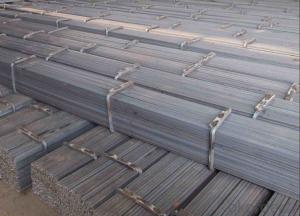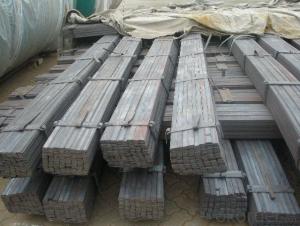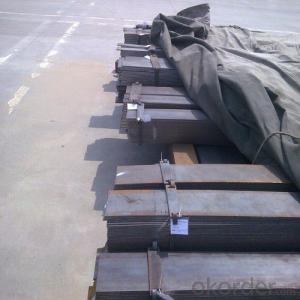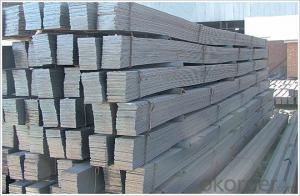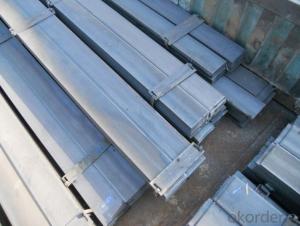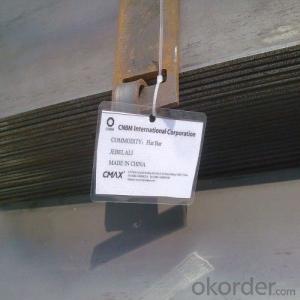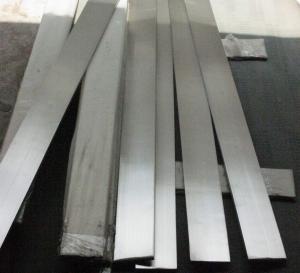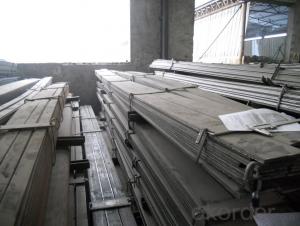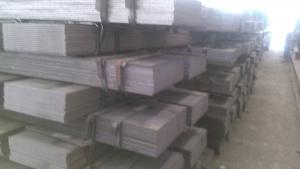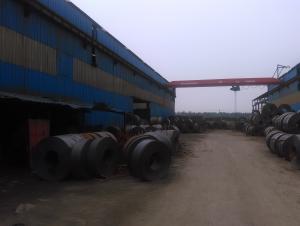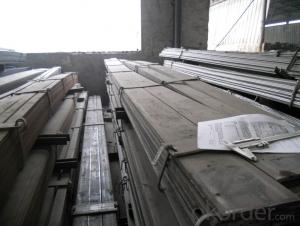Flat Bar Hot Rolled High Quality GB Q235
- Loading Port:
- Tianjin
- Payment Terms:
- TT or LC
- Min Order Qty:
- 25 m.t.
- Supply Capability:
- 200000 m.t./month
OKorder Service Pledge
OKorder Financial Service
You Might Also Like
Product Applications:
Hot Rolled Steel I-Beams are ideal for structural applications and are widely used in the construction of buildings and bridges, and the manufacturing, petrochemical, and transportation industries.
Product Advantages:
OKorder's Steel I-Beams are durable, strong, and resist corrosion.
Main Product Features:
· Premium quality
· Prompt delivery & seaworthy packing (30 days after receiving deposit)
· Corrosion resistance
· Can be recycled and reused
· Mill test certification
· Professional Service
· Competitive pricing
Product Specifications:
Manufacture: Hot rolled
Grade: Q195 – 235
Certificates: ISO, SGS, BV, CIQ
Length: 6m – 12m, as per customer request
Packaging: Export packing, nude packing, bundled
Commodity: Mild Steel Flat Bar Standard: GB;JIS Material: Q195-235;SS400 Brand name: FLATSPACE Origin place: China Thickness: 3mm-30mm Width:20mm-200mm Length: Max 12m Certification: SGS/BV Chemical composition of Q235
Physical properties of Q235
| ||||||||||||||||||||||||||||||||||||||||||||||||||||||||||||||||||||||||||
FAQ:
Q1: How soon can we receive the product after purchase?
A1: Within three days of placing an order, we will begin production. The specific shipping date is dependent upon international and government factors, but is typically 7 to 10 workdays.
Q2: What makes stainless steel stainless?
A2: Stainless steel must contain at least 10.5 % chromium. It is this element that reacts with the oxygen in the air to form a complex chrome-oxide surface layer that is invisible but strong enough to prevent further oxygen from "staining" (rusting) the surface. Higher levels of chromium and the addition of other alloying elements such as nickel and molybdenum enhance this surface layer and improve the corrosion resistance of the stainless material.
Q3: Can stainless steel rust?
A3: Stainless does not "rust" as you think of regular steel rusting with a red oxide on the surface that flakes off. If you see red rust it is probably due to some iron particles that have contaminated the surface of the stainless steel and it is these iron particles that are rusting. Look at the source of the rusting and see if you can remove it from the surface.
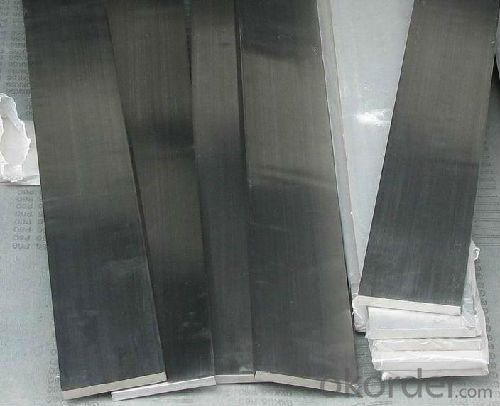
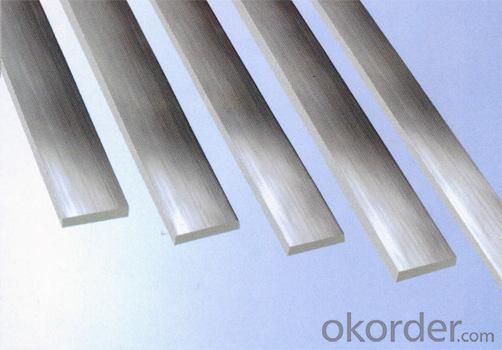
- Q: What is the fire resistance of a steel flat bar?
- The fire resistance of a steel flat bar depends on various factors such as the thickness and composition of the steel, as well as the duration and intensity of the fire. However, in general, steel has a high fire resistance due to its high melting point and low thermal conductivity. It can withstand fire for a significant amount of time before losing its structural integrity.
- Q: What are the different cleaning methods for steel flat bars?
- There are several cleaning methods that can be used to clean steel flat bars effectively. The choice of method may depend on the level of dirt or grime present on the bars and the desired outcome. 1. Soap and water: This is a simple and effective method for removing light dirt and dust from steel flat bars. Use a mild detergent or soap mixed with warm water and a soft cloth or sponge to gently clean the surface. Rinse thoroughly and dry with a clean cloth. 2. Vinegar or lemon juice: For tougher stains or rust spots, a mixture of vinegar or lemon juice and water can be used. Apply the solution to the affected areas, let it sit for a few minutes, and then scrub with a soft brush or cloth. Rinse thoroughly and dry. 3. Baking soda paste: Baking soda can be used as a gentle abrasive to remove stains and restore the shine of steel flat bars. Mix baking soda with water to form a thick paste, then apply it to the surface. Let it sit for a few minutes, scrub gently with a soft brush, and rinse thoroughly before drying. 4. Commercial stainless steel cleaners: There are various stainless steel cleaning products available in the market specifically designed for steel surfaces. These cleaners can effectively remove dirt, stains, and fingerprints from steel flat bars. Follow the instructions on the product label for best results. 5. Polishing compounds: To give steel flat bars a shiny and polished appearance, polishing compounds can be used. Apply a small amount of the compound to a soft cloth and rub it evenly on the surface of the bars in a circular motion. Buff the bars with a clean cloth to remove any excess compound and bring out the desired shine. It is important to note that when using any cleaning method, it is recommended to test a small inconspicuous area first to ensure that it does not damage or discolor the steel flat bars. Additionally, always rinse and dry the bars thoroughly after cleaning to prevent water spots or potential corrosion.
- Q: What are the different standards for steel flat bars?
- There are several different standards for steel flat bars, which vary depending on the country and industry. Some commonly used standards include ASTM A36, ASTM A572, DIN 17100, EN 10025-2, and JIS G3101. These standards specify the chemical composition, mechanical properties, dimensions, and tolerances for steel flat bars, ensuring consistency and quality in their production and use.
- Q: How do you determine the maximum load capacity of a steel flat bar?
- The maximum load capacity of a steel flat bar can be determined through a combination of engineering calculations and testing. Firstly, the material properties of the specific steel alloy used in the flat bar need to be known, such as its yield strength and ultimate tensile strength. These properties can be obtained from the material manufacturer or reference sources. With the material properties in hand, engineering calculations can be performed to determine the maximum load the flat bar can handle before it reaches its yield strength or ultimate tensile strength. Factors like the cross-sectional area and length of the flat bar, as well as the type of load (e.g., bending, tension, compression), must be considered in these calculations. To validate the calculated maximum load capacity, physical testing is often conducted. This involves subjecting the steel flat bar to gradually increasing loads until it deforms or fractures. The maximum load at which the bar remains intact is then considered its load capacity. Ultimately, determining the maximum load capacity of a steel flat bar requires a combination of theoretical calculations and experimental testing to ensure accurate and reliable results.
- Q: Are steel flat bars suitable for load-bearing shelves or platforms?
- Yes, steel flat bars are suitable for load-bearing shelves or platforms. Steel is known for its strength and durability, making it a reliable choice for supporting heavy loads. The flat shape of the bars provides stability and even weight distribution, making them ideal for load-bearing applications.
- Q: What are the advantages of using steel flat bars?
- There are several advantages of using steel flat bars. Firstly, steel is a highly durable and strong material, making flat bars made from steel ideal for load-bearing and structural applications. Additionally, steel flat bars are resistant to corrosion, which improves their longevity and makes them suitable for outdoor use. Steel flat bars also offer excellent versatility and can be easily fabricated into various shapes and sizes, allowing for flexibility in design and construction projects. Moreover, steel flat bars have a high strength-to-weight ratio, making them lighter than other materials of similar strength, resulting in easier handling and transportation. Lastly, steel is a sustainable and recyclable material, aligning with environmental considerations and promoting sustainability in construction and manufacturing industries.
- Q: Can steel flat bars be used for making brackets or mounting hardware?
- Indeed, brackets or mounting hardware can be fashioned using steel flat bars. Steel boasts exceptional strength and durability, rendering it a perfect substance for crafting robust brackets and mounting hardware. Steel flat bars are malleable, easily tailored, severed, and fused to meet precise specifications, while their flat exterior furnishes a steady foundation for mounting diverse elements. Furthermore, steel's corrosion resistance guarantees the longevity and unfaltering performance of the brackets or mounting hardware.
- Q: How do steel flat bars compare to granite flat bars?
- When comparing steel flat bars and granite flat bars, it is important to consider their differences. To begin with, steel flat bars are made from a strong and durable material, making them highly resistant to bending and breaking. On the other hand, granite is a natural stone known for its strength and durability, although it is not as strong as steel and can crack or chip under heavy loads or impacts. In terms of versatility, steel flat bars have the upper hand. They can be easily cut, welded, and shaped to fit specific requirements, which makes them commonly used in construction, manufacturing, and fabrication industries. Granite flat bars, however, are primarily used in the construction and design of countertops, flooring, and other architectural elements. The aesthetic appeal is another factor to consider. Steel flat bars have a sleek and industrial look, making them suitable for contemporary designs. Granite flat bars, on the other hand, have a natural and timeless beauty. They come in various colors and patterns, making them a popular choice for adding elegance and sophistication to interior and exterior spaces. When it comes to maintenance, steel flat bars require regular cleaning and occasional rust prevention measures to maintain their appearance and prevent corrosion. Granite flat bars, on the other hand, are relatively low maintenance. They are naturally resistant to stains, scratches, and heat, making them easy to clean and maintain. Lastly, cost is an important consideration. Steel flat bars are generally more affordable than granite flat bars. While the price of granite varies depending on quality and availability, it is generally more expensive than steel due to its natural sourcing and fabrication process. In conclusion, steel flat bars and granite flat bars have different strengths and weaknesses. Steel offers durability, versatility, and affordability, while granite provides natural beauty, strength, and low maintenance. Ultimately, the choice between the two depends on the specific requirements, budget, and desired aesthetic of the project.
- Q: How are steel flat bars made?
- Steel flat bars are made through a process called hot rolling, where steel billets are heated and passed through a series of rolling mills to gradually reduce their thickness, resulting in the formation of flat bars with consistent dimensions.
- Q: How do you check the straightness of a steel flat bar?
- To check the straightness of a steel flat bar, you can follow these steps: 1. Visual Inspection: Start by visually inspecting the flat bar for any visible curves or bends. Place the bar on a flat surface and use your eyes to identify any deviations from a straight line. Look for any warping, twisting, or bowing along the length of the bar. 2. Physical Evaluation: Run your hand along the length of the bar, feeling for any irregularities or deviations from a straight line. Pay close attention to any areas that feel uneven or have noticeable bumps. This step allows you to detect any subtle curves that might not be visible through visual inspection alone. 3. Straight Edge Method: Place a straight edge, such as a ruler or a level, along the length of the steel flat bar. Ensure that the straight edge makes full contact with the surface of the bar. Observe if there are any gaps or spaces between the straight edge and the bar. If the straight edge cannot lay flat on the bar without any spaces, it indicates that the bar is not perfectly straight. 4. Measuring Tool: Use a precision measuring tool, such as a caliper or a feeler gauge, to measure the gap between the straight edge and the steel flat bar at various points along its length. By measuring these gaps, you can determine the extent of any curvatures or deviations from a straight line. The larger the gap, the more pronounced the bend or curve is. 5. Repeat and Average: Repeat the above steps at multiple locations along the length of the flat bar to ensure an accurate assessment. It is common for steel flat bars to have slight variations in straightness, so checking at multiple points provides a more comprehensive evaluation. After measuring at different locations, average the results to get an overall understanding of the flat bar's straightness. By following these steps, you can assess the straightness of a steel flat bar and determine whether it meets your desired criteria.
Send your message to us
Flat Bar Hot Rolled High Quality GB Q235
- Loading Port:
- Tianjin
- Payment Terms:
- TT or LC
- Min Order Qty:
- 25 m.t.
- Supply Capability:
- 200000 m.t./month
OKorder Service Pledge
OKorder Financial Service
Similar products
Hot products
Hot Searches
Related keywords
